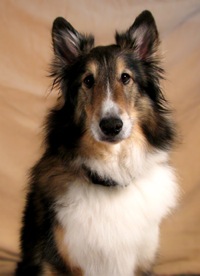During the winter months, there are hazards to our dogs as they venture outdoors. The area of the body that seems to feel the cold the most is the paws. Even just playing out in the yard or at the park can result in snow balling up and freezing to the paws causing pain and discomfort to the dog. There are a number of steps that you can take to ensure you keep those paws as warm as possible.
Firstly, proper paw maintenance. Be sure to trim the hair on the bottom of the paws and between the toes to prevent snow from clumping and freezing. There is a misconception that leaving the paw hair long will provide natural insulation against the cold, but this is incorrect. Long paw hair allows snow to clump, where if the hair is trimmed there is a lesser chance for snow to ball up and cling. Check out a previous article for instructions on one method of paw trimming: Grooming Those Sheltie Feet.
There are also many items available to help keep the snow off of the paws. The most common is likely booties. There are many styles of booties to choose from, all with varying price tags. I have not had success with booties, they never seem to stay on properly, and if they do then it alters the way that the dog walks and their ability to get grip on slippery surfaces. Instead, I prefer products such as Musher's Secret Paw Wax. This stuff is amazing! It is roughly the consistency of firm Vaseline. Smear a thin layer on the bottom of the paws and between the toes and it forms a waterproof breathable layer that keeps the moisture away from the paws, prevents snow from clinging and balling up, and also blocks against road salts and chemicals. Road salt and chemicals can burn and irritate the skin, as well as cause serious health problems if ingested after the dog licks their paws. Musher's Secret keeps the chemicals away from the skin, then a quick wipe of the feet before re-entering the house clears them away completely. The wax is not overly greasy, I haven't had any issues with it staining carpet or furniture. Though on indoor flooring, it can be a little slippery so be sure to wipe the feet when coming back indoors.
Be sure to also monitor your dogs while outside. Take cues from them as to when it is too cold. Your first sign will likely be if the dog is holding their paws up out of the snow, also reluctance to walk or play or constant running back to the door signals time to go back indoors and warm up. My rule of thumb, if the dogs are playing hard with no sign of discomfort, then there is no need to worry. Watch the body language of your dogs, they can't tell you verbally when they are cold, so you need to be an honest judge.
Once back inside, check the dog over for hidden ice clumps. Chest/neck hair, armpits, inner thigh, and up the legs are common "clump" areas. If you do find clumps, use a dry towel to melt the clumps enough to gently remove them from the fur. Some dogs enjoy chewing the clumps off themselves, but allowing that risks the dog breaking or damaging the hair itself and may irritate the skin. It's better, then, to help your dog out and melt the clumps with a dry towel.
1 week ago






3 comments:
living in Florida - we don't worry too much about snow!
But get that nose white for us!
ourfurryfamily
Thanks for the good post. I bought the wax and have trimmed up Ruby's paws. It really helped alot. She is more comfortable outside.
Ruby's mom
Thank you for your post. I am finding though that my sheltie's problem is not with his paws, he gets huge snowballs attached to his skirts and his (I call it a bib) He doesn't act like it is bothering him, by biting at it or anything, but he does start to walk funny, due to the size of the balls and amount. We tried to pull them off, and it just pulls his fur. We had to use a blow dryer to melt the snowballs. But how can I prevent them from forming?
Post a Comment